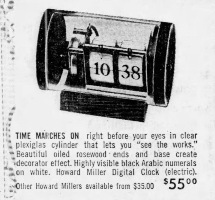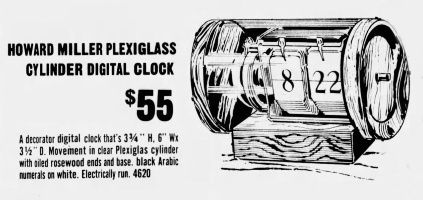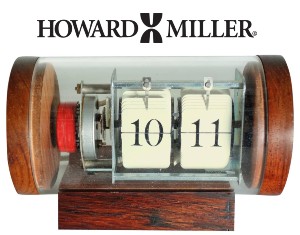 We're here to discuss a vintage flip clock that flip clock fans usually call "The Howard Miller Flip Clock." However, on online auctions you will see this clock referred to as some variation of: the Rare Vintage Arthur Umanoff George Nelson Howard Miller Flip Clock. In recent years these clocks have sold for exceedingly high prices upwards of 500 dollars and even over $1000 dollars. Why, exactly would these clocks be priced so high, when were they made? What are they made of ... "gold?, why do they have 3 men's names?, Are they really exceedingly rare and finally ... are they overpriced?
We're here to discuss a vintage flip clock that flip clock fans usually call "The Howard Miller Flip Clock." However, on online auctions you will see this clock referred to as some variation of: the Rare Vintage Arthur Umanoff George Nelson Howard Miller Flip Clock. In recent years these clocks have sold for exceedingly high prices upwards of 500 dollars and even over $1000 dollars. Why, exactly would these clocks be priced so high, when were they made? What are they made of ... "gold?, why do they have 3 men's names?, Are they really exceedingly rare and finally ... are they overpriced?
For simplicity sake, we're going to call this clock the Howard Miller Flip Clock. Period. I'll explain the other names in a minute. It's curious to note that there was another flip clock produced by Howard Miller around the same time period ... we'll discuss that one and give it a name later, I don't know. Maybe we'll call it "Fred."
Just look at it. The Howard Miller Flip Clock, if you have an interest in flip clocks, or basically, time keeping in general this clock gets your attention. It looks vintage and sort of contemporary at the same time. When I first saw it I couldn't decide if it looked like an up-cycled flip clock that you might see on Esty.com or if it was a long lost early flip clock from the 1930s.
The Howard Miller Flip Clock first showed up in newspaper advertising right around 1969. Yes, 1969. It's vintage but not exactly an antique clock at all. Here we see the clock in this newspaper advertisement from The Philadelphia Inquirer, November 30, 1969. They're calling it the "Howard Miller Digital Clock (electric). We have a video out about when so-called digital clocks became known as flip clocks - if you're interested. In this ad from the the Fort Lauderdale News, June 16, 1971 you can see they called it the "Howard Miller Plexiglass Cylinder Digital Clock." What is it with this clock and the naming confusion? In 1971 it was still priced at $55.00. Adjusted for inflation, $55.00 in 1971 is equal to about $355 in 2020. That was pricey for flip clock at that time. On the same page in this newspaper, we can see the common GE model 8114 going for a measly $9.87. So as you can see, the Howard Miller Flip Clock arrived on the scene about the time all the other makers were putting out flip clocks. The clock's run seems to have slowed or ended around 1972 since no advertisement were found after than time. As you noticed from these ads, the cylinder of the clock is not glass but Plexiglas. While PLEXIGLAS® was registered as a brand in 1933, it's use in the making of clocks did not occur significantly until the mid to late 1960s. The wood base and ends of this clock are said to oiled rosewood - not a cheap wood these days.
As a side note:
The there are several different species of rosewood trees. True rosewood comes from the Brazilian rosewood, Indian rosewood and Madagascar rosewood. These tend to command the highest price internationally. Rosewoods are known for their density and tight grain as well as their amazing red/dark red coloring. In addition to the beautiful coloring, rosewoods actually exude a rose-like scent. It is reported that this odor remains in the wood for hundreds of years and can still be even be smelled in antiques when they're scratched or refinished.
The illegal trade in rosewood has become the world's most lucrative form of wildlife crime, surpassing the illegal trade of elephant ivory. Rosewood is now protected worldwide, but China seems to be the largest importer of rosewood, legal or not.
Back to Clock!
Let's look into a little history about the maker of this clock and learn about some of the names this clock has collected over the years.
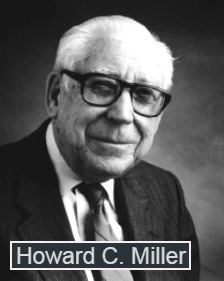 The Howard Miller Clock Company was founded in 1926 as the Herman Miller Clock Company which was a division of the Herman Miller office furniture manufacturing company. In 1937 clock making was separated from the furniture business and this company took the name of Herman Miller's son, Howard C. Miller (1905-1995).
The Howard Miller Clock Company was founded in 1926 as the Herman Miller Clock Company which was a division of the Herman Miller office furniture manufacturing company. In 1937 clock making was separated from the furniture business and this company took the name of Herman Miller's son, Howard C. Miller (1905-1995).
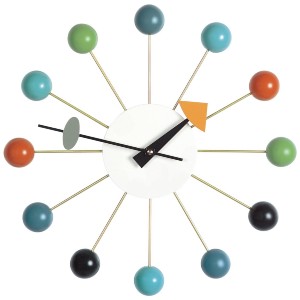 Howard Miller Clocks over the years have been of all the classic types and styles from mantel clocks, wooden wall clocks, and grandfather clocks. But in the late 1940s the Howard Miller Clock Company embraced the latest in design style at the time now often termed the "Mid-century Modern American design movement" or simply "Mid-century Modern." It was right near the start of this period, in 1947, that an American designer named George Nelson started designing clocks for Howard Miller. The first and most iconic of these was simply called, the Ball Clock.
Howard Miller Clocks over the years have been of all the classic types and styles from mantel clocks, wooden wall clocks, and grandfather clocks. But in the late 1940s the Howard Miller Clock Company embraced the latest in design style at the time now often termed the "Mid-century Modern American design movement" or simply "Mid-century Modern." It was right near the start of this period, in 1947, that an American designer named George Nelson started designing clocks for Howard Miller. The first and most iconic of these was simply called, the Ball Clock.
It is curious to note the during this period at the Howard Miller Clock Company, clocks received very simple designations or names. For example, the ball clock was called "Clock 4755." What many do not realize is the Howard Miller Flip Clock we are discussing here was "Clock 4620." Unfortunately, this number was not stamped on the clock in any way, so contemporary flip clock collectors and sellers don't know what to call this clock. It should be noted that the clock numbers were not assigned sequentially, so the 4620 did not come before the ball clock (4755).
At one point, I followed an online argument among horologists or clock collectors, some who took issue with the Howard Miller Flip Clock being associated with the name "George Nelson" asserting that it was Arthur Umanoff who designed clocks for Howard Miller in the 1960s (which is true). It is my opinion that strictly speaking, the clock should be referred to as the Arthur Umanoff designed Howard Miller Flip Clock. However including the name George Nelson along with Umanoff could be considered acceptable. Without a doubt, George Nelson the famous mid-century modern furniture designer, really got the ball rolling in modern clock design for Herman Miller and immediately preceded Umanoff's influence at the clock maker. Yet the fact remains - the Howard Miller flip clock was almost certainly designed by the post-modernist designer, Arthur Umanoff - who should receive credit for this highly valued flip clock.
The Lesser Known Howard Miller Flip Clock
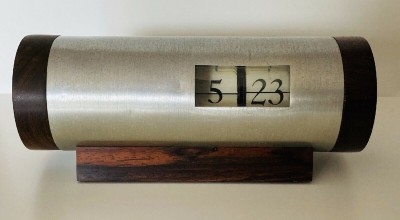 In 1968 Howard Miller Clock Company of Zeeland Michigan was recognized by the American Institute of Interior Design during their 23rd annual international design awards program for the design of a "digital" clock with a satin aluminum cylinder and rosewood ends and base. This clock can be seen in newspapers as early as 1967. This clock may have preceded the more famous Plexiglas cylinder clock (what we now call the "Howard Miller Flip Clock"). Yet, it still does not receive the attention these days as the high dollar Howard Miller Flipper. We can just call this the Aluminum Cylinder Howard Miller Flip Clock, if you like. Or the "Award-winning Aluminum Cylinder Howard Miller Flip Clock."
In 1968 Howard Miller Clock Company of Zeeland Michigan was recognized by the American Institute of Interior Design during their 23rd annual international design awards program for the design of a "digital" clock with a satin aluminum cylinder and rosewood ends and base. This clock can be seen in newspapers as early as 1967. This clock may have preceded the more famous Plexiglas cylinder clock (what we now call the "Howard Miller Flip Clock"). Yet, it still does not receive the attention these days as the high dollar Howard Miller Flipper. We can just call this the Aluminum Cylinder Howard Miller Flip Clock, if you like. Or the "Award-winning Aluminum Cylinder Howard Miller Flip Clock."
So why does this clock seem to be selling so high? I think that it's possible some people are mistaking the clock for an antique. It does resemble very early flip clocks, the New Haven Flip Clocks which were produced around 1937-1939.
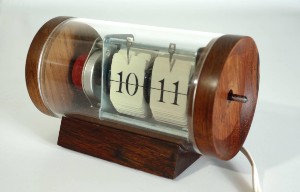 The Enigmatic Howard Miller Flip Clock. Also known as the George Nelson, Arthur Umanoff Howard Miller Plexiglas Cylinder Digital clock, or Clock 4620 - an expensive clock in the day which has only gotten more expensive over the years. Whether the clock is worth a 1000 dollars or not is up to the buyers. It's probably not as rare as some think. But, as they say, "it's worth what someone would pay for it." Personally, I'd love to add this to the Flip Clock Fans collection. But for now, I'll just keep looking at it online.
The Enigmatic Howard Miller Flip Clock. Also known as the George Nelson, Arthur Umanoff Howard Miller Plexiglas Cylinder Digital clock, or Clock 4620 - an expensive clock in the day which has only gotten more expensive over the years. Whether the clock is worth a 1000 dollars or not is up to the buyers. It's probably not as rare as some think. But, as they say, "it's worth what someone would pay for it." Personally, I'd love to add this to the Flip Clock Fans collection. But for now, I'll just keep looking at it online.

